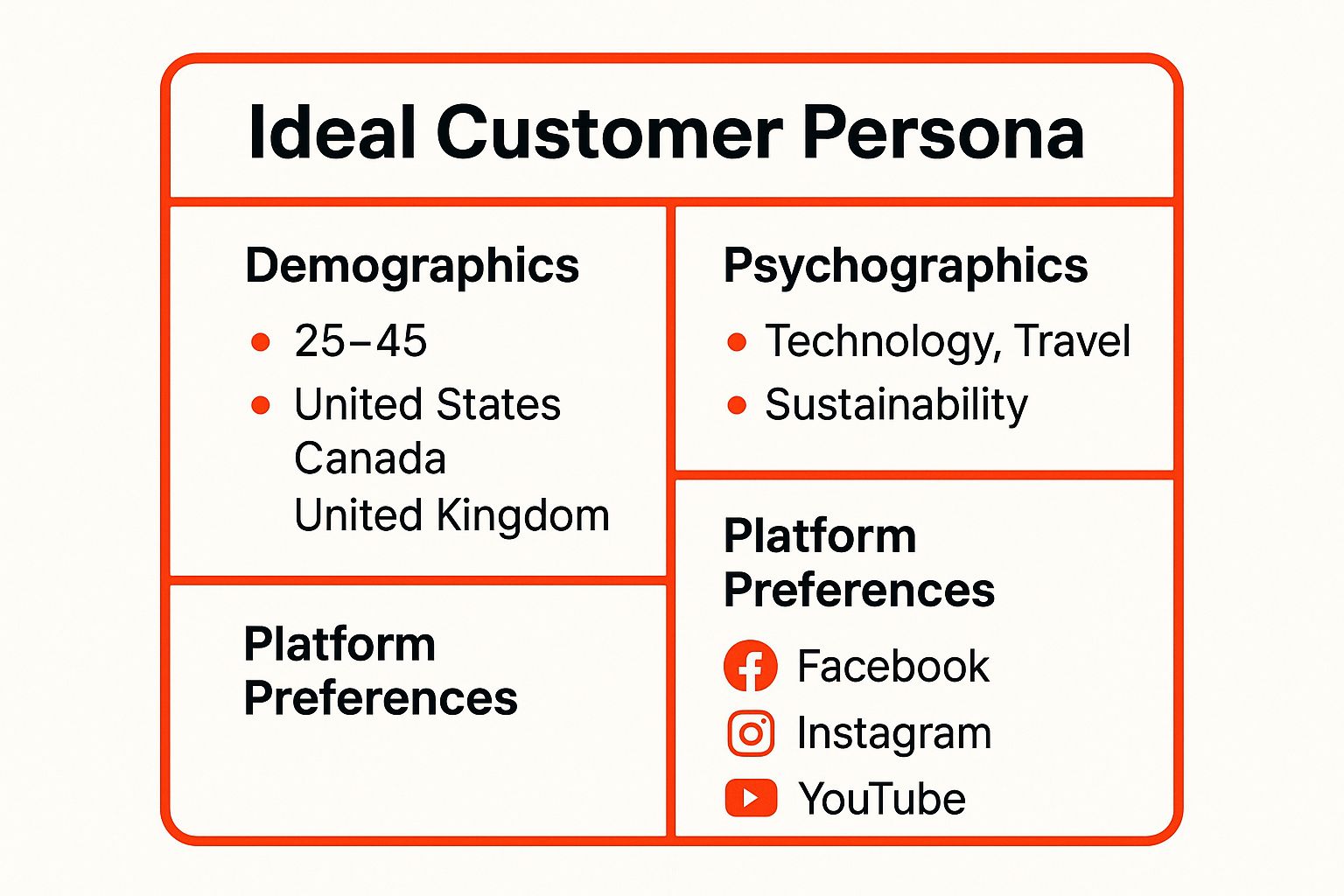
Top 8 Social Media Marketing Tips for Small Business in 2025
In the competitive world of small business, a strong social media presence is non-negotiable for growth. Yet, with limited time and resources, deciding where to focus your marketing efforts can be a significant challenge. This guide is built to cut through the noise and provide clear, actionable direction. We have curated a list of proven social media marketing tips for small business owners designed to transform your online channels into powerful engines for customer acquisition and brand loyalty.
Forget abstract theories and generic advice. Each tip in this listicle is designed for immediate, practical implementation. You'll find concrete examples and specific guidance to help you define your audience, create compelling content, and engage authentically with your community. These strategies will equip you to achieve measurable results, build a standout brand, and connect with customers in meaningful ways. For a comprehensive overview of how to leverage these platforms effectively, you can also dive deeper into a full guide on Social Media Marketing for Small Business.
Ready to move beyond simple posting and start building a strategic social media machine? Let’s dive into the tips that will help you grow.
1. Define Your Target Audience and Ideal Customer Persona
Before you post a single piece of content, the most crucial step is to define exactly who you are trying to reach. Broadcasting your message to everyone means you'll connect with no one. This is where creating an ideal customer persona becomes one of the most effective social media marketing tips for any small business. A persona is a detailed, semi-fictional profile of your perfect customer, including their goals, challenges, and online behavior.
This foundational strategy ensures every post resonates. For example, a local accounting firm's persona might be "Freelancer Fred," a 35-year-old graphic designer struggling with quarterly tax filings. Knowing this, the firm can create a LinkedIn post titled "3 Common Tax Deductions Every Freelancer Misses," directly addressing Fred's pain point and positioning the firm as a helpful expert. This is far more effective than a generic "We do taxes" post.
How to Create Your Customer Persona
To build an effective persona, you need to dig into data and real-world feedback. Don't guess; investigate.
- Analyze Your Data: Use Google Analytics and your social media platform insights (like Facebook's Audience Insights or Instagram's Follower data) to gather demographic information. Actionable Insight: Look at the "Age & Gender" and "Top Cities" data in your Instagram Insights to get a clear picture of who is already engaging with you.
- Survey Your Customers: Create a simple survey using a free tool like Google Forms and email it to your top 20 customers. Practical Example: Ask questions like, "What is the biggest challenge you face in [your industry]?" and "Which social media app do you open first in the morning?"
- Identify Negative Personas: Just as important is knowing who you are not targeting. For a high-end wedding planner, a negative persona might be "Budget-Conscious Brian," who is looking for DIY solutions. This helps you avoid wasting ad spend on audiences unlikely to convert.
This infographic provides a snapshot of what a completed persona summary might look like, highlighting the essential data points to guide your strategy.

Visualizing these components helps your team quickly understand who they are creating content for, ensuring consistency and relevance across all channels. Remember to create 2-3 distinct personas and revisit them quarterly to ensure they remain accurate as your business and the market evolve.
2. Choose the Right Social Media Platforms for Your Business
Spreading your small business too thin across every social media channel is a common mistake that drains resources and dilutes your message. Instead of trying to be everywhere, a more effective social media marketing tip is to strategically select 2-3 platforms where your ideal customer is most active and engaged. This focused approach ensures your efforts are concentrated where they will have the greatest impact.
A B2B software company targeting tech startups will find more qualified leads on LinkedIn and Twitter, while a handmade jewelry shop will thrive on visually-driven platforms like Instagram and Pinterest. Practical Example: If your persona "Freelancer Fred" is active in professional groups on LinkedIn, you should prioritize creating content there, not on TikTok. The key is to align your platform choice with your business goals and audience behavior.
How to Select the Right Platforms
Making a strategic choice requires research and an honest assessment of your capabilities. Don't just follow the trends; follow your audience.
- Analyze Your Competitors: Look at where your direct competitors are succeeding. Actionable Insight: Use a social media tool to see which of their posts get the most engagement. If their LinkedIn articles consistently outperform their Instagram posts, that’s a strong signal about where the audience is.
- Align with Your Content Strengths: Be realistic about the type of content you can consistently produce. If you're great on camera and can create quick, helpful tutorials, YouTube Shorts and TikTok are ideal. If you're a strong writer, focus on LinkedIn articles or detailed Facebook posts.
- Survey Your Audience: Ask your existing customers where they spend their time online. Practical Example: Add a simple question to your post-purchase thank you email: "Where do you follow us on social media? (Instagram / Facebook / LinkedIn / Other)".
- Test and Measure: Before fully committing, run small, low-budget ad campaigns on a few potential platforms. Actionable Insight: Spend $50 on a targeted ad campaign on both Facebook and Pinterest. After a week, compare the click-through rate (CTR) and cost-per-click (CPC) to see which platform delivers better results for your budget.
By focusing your energy on the right channels, you can build a stronger, more engaged community. This targeted approach allows for deeper connections and more consistent content, which are critical for small business growth.
3. Create Valuable, Consistent Content with a Strategic Content Calendar
Consistency is the engine of social media success, but it's impossible to maintain without a plan. A content calendar is your strategic roadmap, allowing you to organize your posts in advance, ensure a steady flow of high-quality content, and align every update with your business goals. Instead of scrambling for last-minute ideas, you can build a cohesive brand narrative that keeps your audience engaged.
This is one of the most effective social media marketing tips for small business because it prevents content gaps. Practical Example: A local fitness studio can use a calendar to schedule "Motivation Monday" posts, "Workout Wednesday" video tips, and "Flex Friday" client spotlights. This creates a predictable and valuable rhythm, training followers to look forward to specific content on certain days and transforming social media from a reactive chore into a proactive marketing channel.

How to Build a Strategic Content Calendar
An effective calendar is more than just a schedule; it's a tool for strategic execution. To ensure your content is valuable and consistent, implement a solid strategy by following this practical guide to building a social media content calendar.
- Apply the 80/20 Rule: Dedicate 80% of your content to providing value (educational tips, entertainment, community stories) and 20% to direct promotion. Practical Example: If you post 5 times a week, 4 posts should be helpful or fun, and only 1 should be a direct "buy now" message.
- Batch Create Your Content: Set aside a 3-hour block every two weeks to write all captions, design graphics, and film videos. This drastically improves efficiency and ensures creative quality remains high.
- Plan for Key Dates: Populate your calendar with holidays, industry events, and seasonal campaigns well in advance. Actionable Insight: A coffee shop should plan its Pumpkin Spice Latte campaign content in July, not the last week of August.
- Leave Room for Flexibility: While planning is crucial, social media is dynamic. Reserve one "floating" content slot per week to engage with a real-time trend or share a timely piece of user-generated content.
By implementing these social media marketing best practices, you can create a content machine that consistently delivers value and drives results.
4. Engage Authentically with Your Community and Followers
Social media is not a one-way broadcast channel; it's a dynamic, two-way conversation. The most effective social media marketing tips for small business owners emphasize building genuine relationships, not just accumulating followers. Authentic engagement means actively participating in conversations, responding to comments and messages promptly, and showing the human side of your brand.
This approach builds trust and brand loyalty that paid ads alone cannot achieve. Practical Example: Wendy's has famously built a massive Twitter following not by just promoting its menu, but by engaging with followers through witty, humorous, and highly responsive interactions. For a small business, this could be a local bookstore owner responding to a comment with a personalized book recommendation based on the user's profile. This makes the brand more relatable and memorable.

How to Engage Your Community Effectively
Building an engaged community requires a consistent and genuine effort. Here are actionable steps to start fostering meaningful connections.
- Respond Promptly and Personally: Aim to answer comments within a few hours. Actionable Insight: Instead of a generic "Thanks!", try "Thanks, Sarah! So glad you enjoyed the latte. Did you try it with oat milk? It's a game-changer!" This shows you're paying attention.
- Ask Open-Ended Questions: Don't just post statements. Practical Example: A pet groomer could post a photo of a happy dog and ask, "What’s the funniest thing your pet has ever done? Share your stories below! 👇" This directly invites interaction.
- Celebrate User-Generated Content (UGC): When customers share photos featuring your products, reshare them and give credit. This provides authentic content and makes your customers feel appreciated.
- Establish a Clear Brand Voice: Create simple guidelines for your brand’s personality: Are you witty, professional, or warm? Actionable Insight: Create a one-page document with 3-5 "we are" vs. "we are not" statements (e.g., "We are: Playful and encouraging. We are not: Sarcastic or exclusive.") to keep all communications consistent.
By prioritizing these human interactions, you create a vibrant community that is invested in your small business's success. This fosters a loyal customer base that will support your brand far beyond a single purchase.
5. Leverage User-Generated Content and Social Proof
Instead of telling your audience how great your products are, let your customers do it for you. Leveraging user-generated content (UGC) is a powerful strategy that involves encouraging your audience to create and share content featuring your brand. This provides authentic social proof, builds community, and supplies you with a steady stream of genuine content.
This is one of the most effective social media marketing tips for small businesses because it builds trust organically. When potential customers see real people enjoying your products, it acts as a powerful endorsement. Practical Example: A local coffee shop can repost Instagram Stories from patrons tagging their location, or a skincare brand can create an entire "Customer Results" Instagram highlight reel using photos and videos sent in by users.
How to Encourage and Utilize UGC
To effectively integrate UGC, you need to make it easy and rewarding for your customers to participate. A clear and consistent strategy is key.
- Create a Branded Hashtag: Develop a simple, memorable hashtag and promote it everywhere—in your bio, on posts, and on physical packaging. Practical Example: Outdoor brand REI uses #OptOutside to encourage users to share photos of their adventures, generating millions of pieces of brand-aligned content.
- Run Contests and Offer Incentives: Encourage participation by offering rewards. Actionable Insight: Announce a monthly contest where the best customer photo shared with your hashtag wins a $50 gift card. This small investment can generate a wealth of content.
- Always Ask for Permission and Give Credit: Before reposting, send a direct message asking for permission. When you share, always tag and credit the original creator. Practical Example: "We're in love with this beautiful shot from @janedoe! Thanks for sharing, Jane! Want to be featured? Tag us!"
- Showcase UGC Prominently: Don’t just repost UGC to your feed. Feature it in your Instagram Stories, create a dedicated "Community" highlight reel, and embed a UGC gallery on key pages of your website, like product or checkout pages.
6. Utilize Social Media Analytics to Track Performance and ROI
Posting content consistently is only half the battle; understanding what works is what drives growth. Regularly monitoring social media analytics allows you to move from guessing to making data-driven decisions. By tracking key metrics, you can understand which content resonates, when your audience is most active, and which strategies are actually driving sales.
This data-driven approach helps you refine your strategy. Practical Example: A local bakery owner checks her Instagram Insights and sees that her short video Reels showing the croissant-making process get 3x more views and shares than static photos of the final product. She can now decide to create more behind-the-scenes video content to boost engagement. This is a crucial social media marketing tip for small businesses looking to maximize their return on investment (ROI).
How to Effectively Track Your Social Performance
To turn raw data into actionable insights, you need a systematic approach. Focus on the metrics that matter most to your business goals.
- Focus on Key Metrics: Don't get lost in vanity metrics like follower count. Identify KPIs aligned with your goals, such as Engagement Rate (likes + comments + shares / followers), Click-Through Rate (CTR), and Conversion Rate.
- Use UTM Parameters: To track website traffic from social media, use UTM parameters in your links. Actionable Insight: Use Google’s free Campaign URL Builder to create a unique link for your Instagram bio. You can then go into Google Analytics and see exactly how many people clicked that specific link and what they did on your site.
- Establish a Reporting Cadence: Set up a simple monthly report to track your KPIs. This routine helps you spot trends. Practical Example: At the end of each month, note your top 3 performing posts and your worst 3. Look for patterns—do videos always do better? Do questions get more comments?
This video from Ahrefs offers a deeper dive into setting up and tracking social media goals to better measure your ROI.
By consistently analyzing your performance, you create a powerful feedback loop. You learn what your audience wants, deliver more of it, and in turn, achieve better business outcomes from your social media marketing.
7. Implement Strategic Social Media Advertising for Targeted Reach
While organic reach is valuable, its decline on major platforms makes paid advertising essential for guaranteed visibility. Strategic social media advertising allows small businesses to amplify their message, reaching hyper-specific audiences that organic efforts might miss. It's not about spending a lot; it's about spending smart to drive measurable results.
This approach is powerful because it provides control and predictability. Practical Example: A local yoga studio can run a Facebook ad for its "New Student Intro Offer" and target it specifically to women aged 25-45 who live within a 5-mile radius and have expressed interest in "yoga," "wellness," and "Lululemon." This hyper-targeting ensures the ad is only shown to the most relevant potential customers.
How to Get Started with Social Ads
Effective advertising requires a clear plan and ongoing optimization. You don't need a massive budget, but you do need a strategy.
- Start Small and Scale: Begin with a modest budget ($5-$10 per day) to test different ad formats and audiences. Actionable Insight: Run two identical ads but change only one thing—for example, the headline or the image (this is called A/B testing). After 3 days, see which version has a lower cost-per-click, turn off the loser, and put the budget into the winner.
- Leverage Retargeting: Install tracking pixels (like the Meta Pixel) on your website. This allows you to "retarget" ads to people who have already visited your site. Practical Example: You can run an ad that shows the exact product a user left in their shopping cart, reminding them to complete their purchase.
- Create Compelling Ads: Your ad must stop the scroll. Use high-quality visuals, a clear headline, and a strong call-to-action (CTA). Actionable Insight: Instead of a generic "Learn More," try a more specific CTA like "Get Your Free Quote" or "Download the 5-Step Guide."
- Use Lookalike Audiences: Once you have a solid customer base, you can upload your customer email list to create a "lookalike audience." The platform's algorithm will then find new users who share similar characteristics to your best existing customers, giving you a powerful, pre-qualified new audience to target.
Properly implemented, paid social campaigns can accelerate your growth far beyond what organic reach can achieve alone. For businesses looking to maximize their ad spend, collaborating with specialized firms can be beneficial. You can learn more about social media marketing agencies to see how they can enhance your campaigns.
8. Stay Current with Platform Trends and Algorithm Changes
The social media landscape is in a constant state of flux. Algorithms evolve, new features are introduced, and user preferences shift. One of the most critical social media marketing tips for a small business is to remain agile and adapt to these changes. Ignoring platform trends means risking a sudden drop in reach and engagement.
This ensures your strategy remains effective. When Instagram prioritizes Reels, its algorithm rewards early adopters with increased organic reach. Practical Example: A small retail boutique that quickly learned to create simple "outfit of the day" Reels using trending audio saw a significant boost in reach compared to competitors who only posted static photos. They adapted to the platform's new focus and were rewarded for it.
How to Stay Ahead of Social Media Changes
Adapting successfully requires a proactive, not reactive, approach. Build these habits into your weekly routine.
- Follow Official Sources: The best place for information is the source. Follow the official business blogs and creator accounts for each platform (e.g., the Instagram @creators account or the official TikTok for Business blog).
- Join Marketing Communities: Participate in online forums or Facebook Groups dedicated to social media marketing. Actionable Insight: Spend 15 minutes each Monday morning scrolling through a relevant marketing subreddit or Facebook group to see what challenges and trends other marketers are discussing.
- Test New Features Immediately: When a platform rolls out a new feature like Instagram Broadcast Channels or collaborative posts, experiment with it within the first few weeks. Early adoption often comes with a visibility boost.
- Monitor Your Competitors: Keep an eye on what your competitors are doing. Actionable Insight: Set up a list on Twitter or use Instagram's "Favorites" feature to create a private feed of your top 5 competitors. This allows you to quickly see what new formats or trends they're successfully adopting.
8-Point Social Media Marketing Tips Comparison
| Strategy | Implementation Complexity 🔄 | Resource Requirements ⚡ | Expected Outcomes 📊 | Ideal Use Cases 💡 | Key Advantages ⭐ |
|---|---|---|---|---|---|
| Define Your Target Audience and Ideal Customer Persona | Medium 🔄 | Moderate ⚡ | Higher engagement and conversion 📊 | Businesses starting to refine marketing and targeting | Improved content relevance; personalized messaging ⭐ |
| Choose the Right Social Media Platforms for Your Business | Low-Medium 🔄 | Low to Moderate ⚡ | Better ROI and focused efforts 📊 | Small businesses optimizing platform presence | Reduced workload; deeper platform expertise ⭐ |
| Create Valuable, Consistent Content with a Strategic Content Calendar | Medium-High 🔄 | Moderate-High ⚡ | Consistent brand presence and planning 📊 | Brands aiming for cohesive messaging and scheduling | Reduces last-minute stress; better quality content ⭐ |
| Engage Authentically with Your Community and Followers | High 🔄 | High ⚡ | Stronger relationships; increased loyalty 📊 | Brands focusing on customer trust and community building | Builds trust and organic reach; valuable feedback ⭐ |
| Leverage User-Generated Content and Social Proof | Medium 🔄 | Moderate ⚡ | Increased engagement and social proof 📊 | Businesses wanting authentic content and community growth | Builds trust; lowers content creation costs ⭐ |
| Utilize Social Media Analytics to Track Performance and ROI | Medium 🔄 | Moderate ⚡ | Data-driven optimization and ROI 📊 | Businesses aiming to measure and optimize marketing efforts | Enables informed decisions; identifies top content ⭐ |
| Implement Strategic Social Media Advertising for Targeted Reach | Medium 🔄 | Moderate-High ⚡ | Quick reach increase and conversions 📊 | Businesses with budget for paid campaigns targeting audiences | Highly targetable; measurable ROI ⭐ |
| Stay Current with Platform Trends and Algorithm Changes | Medium-High 🔄 | Moderate ⚡ | Maintains competitiveness and visibility 📊 | Businesses needing to adapt continuously to platform shifts | Early adoption advantage; content relevance ⭐ |
Transform Your Social Strategy into a Growth Engine
Navigating the world of social media can feel overwhelming, but it doesn't have to be a complex puzzle. The journey from simply having a presence to creating a powerful growth engine is built on a foundation of consistent, strategic action. We've explored a range of essential social media marketing tips for small business, moving beyond generic advice to provide a clear, actionable roadmap for success.
The core takeaway is this: strategy trumps spontaneity. A successful social media approach isn't about random posts or chasing viral trends. It’s about deeply understanding your audience, choosing the right platforms where they spend their time, and delivering consistent value through a well-planned content calendar. Remember, authentic engagement is your most valuable currency; responding to comments, asking questions, and showcasing user-generated content builds a loyal community that trusts and champions your brand.
From Insights to Actionable Steps
To truly transform your efforts, you must treat social media as an integral part of your business strategy, not an afterthought. This means moving from theory to practical application.
- Start with an Audit: Before you implement anything new, review your current efforts. Which platforms are driving results? Where is your audience most engaged? Use the analytics tips we covered to establish a baseline.
- Prioritize One or Two Platforms: Don't try to conquer every platform at once. Based on your audience persona, select the one or two channels with the highest potential impact and focus on mastering them first.
- Commit to a Content Schedule: Using a simple content calendar, plan your posts for the next two weeks. This simple step eliminates guesswork and ensures you maintain a consistent presence, which is crucial for algorithm visibility.
- Dedicate Time for Engagement: Block out 15-30 minutes each day specifically for community interaction. This includes replying to comments, engaging with follower content, and participating in relevant conversations.
The Long-Term Impact of a Solid Strategy
Mastering these concepts is more than just a marketing exercise; it's a direct investment in your business's sustainability and growth. A well-executed social media strategy builds brand equity, generates qualified leads, and creates a direct line of communication with your customers. It allows you to gather real-time feedback, adapt to market changes, and foster a community that feels seen and heard.
The social media marketing tips for small business outlined in this guide are not a one-time checklist but a continuous cycle of planning, executing, analyzing, and refining. By embracing this iterative process, you empower your business to not only survive but thrive in the digital landscape. Start small, stay consistent, and focus on building genuine connections. The results will follow.
Ready to tap into one of the most powerful and underutilized platforms for authentic community engagement? If you want to leverage niche communities on Reddit to drive high-intent traffic and conversions but aren't sure where to start, our team can help. Partner with Reddit Agency to craft a strategy that turns targeted conversations into loyal customers. Learn more about our Reddit marketing services and unlock a new channel for growth.